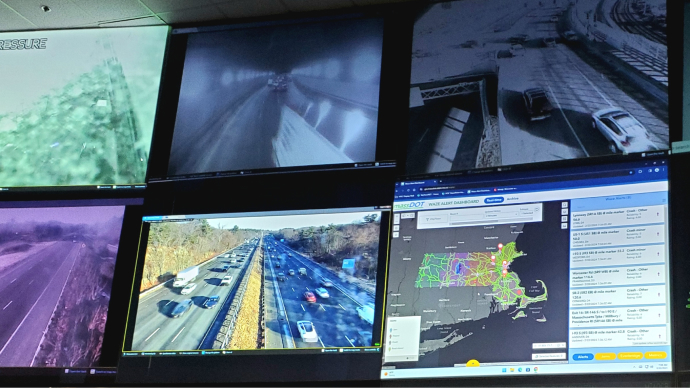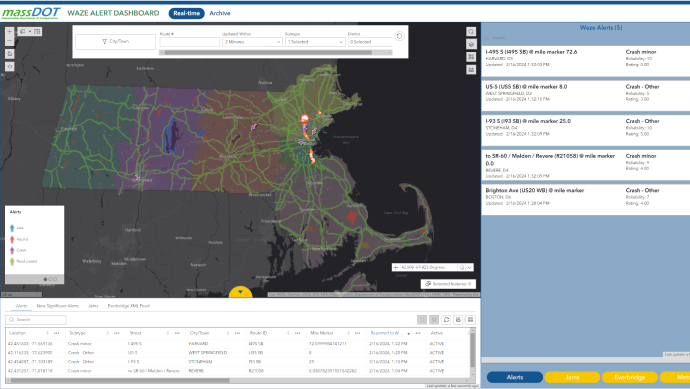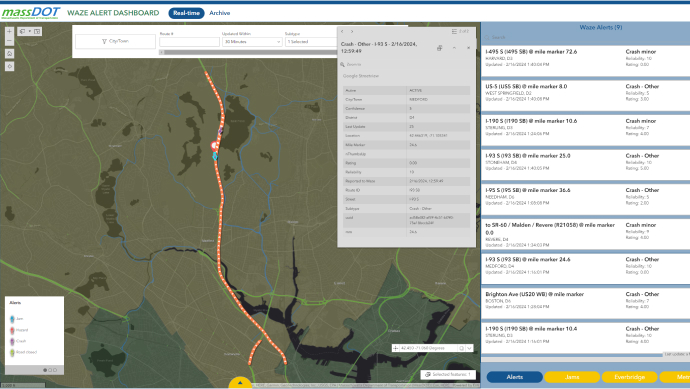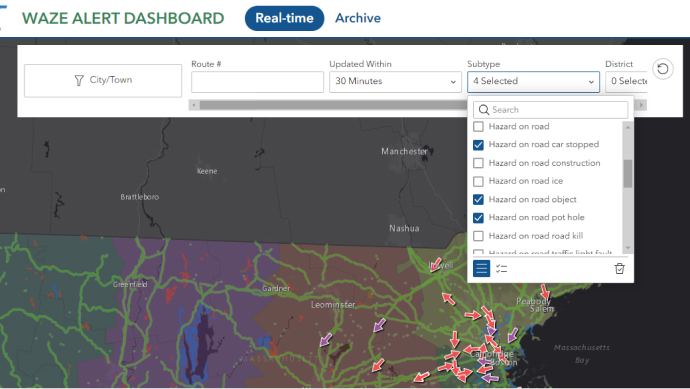
“The Highway Operations Center’s use case of using data [in] real-time was a new challenge, and it was met. [Velocity] provides new efficiencies to operations, and the Waze feed has pertinent information the HOC needs to do its job.”
case study
Each day, up to 5 million vehicles travel more than 154 million miles on all roads across the state of Massachusetts. This total includes nearly 4.75 million licensed Massachusetts drivers and more than 200,000 from out of state. The Massachusetts Department of Transportation (MassDOT), which is comprised of several distinct divisions, is responsible for providing a safe and reliable transportation system for all travelers. The Highway Division of MassDOT builds and maintains infrastructure such as roads, bridges, and tunnels in every region of the state.
Challenge
The Highway Operations Center (HOC) under the Massachusetts Department of Transportation enhanced its daily monitoring of state roadways with Waze, but wanted a more reliable tool to enrich this real-time data with location details to help improve emergency response times.
Solution
ArcGIS Velocity
Results
The revamped Waze and ArcGIS Velocity integration has increased reliability for the HOC and improved access to real-time data, with Waze features like clustered alerts and alert scoring helping the HOC deploy assets to the correct location of an event.
The Highway Operations Center (HOC) under the Highway Division, located in South Boston, is the 24/7/365 traffic management center of MassDOT. The HOC strives to provide reliable means of monitoring state roadways and facilities, and on-site staff manage calls and dispatch personnel to emergency events like auto crashes. To improve emergency response times, the HOC enhanced its daily monitoring with Waze, a free turn-by-turn GPS navigation application that provides real-time traffic updates.
To ingest the real-time data, HOC staff leveraged a solution that enables users to connect to and analyze virtually any type of streaming data. However, they wanted a more reliable tool that would allow them to enrich the data with even more event information (like visualizing an incident location on a map) to reduce emergency response times and help them more efficiently detect and manage incidents.
The HOC turned to the geographic information system (GIS) team under MassDOT’s Office of Transportation Planning for assistance. The GIS team deployed ArcGIS Velocity for real-time and big data processing and analysis and integrated the Waze data feed. This has enabled the HOC to see the most up-to-date information to better dispatch emergency personnel when needed and improve safety on state roadways.
HOC staff view data from multiple sources on different screens such as X (formerly known as Twitter), local news, and Mass511 traffic cameras, and take phone calls from citizens or state police to help them identify emergency events. However, the HOC wanted to begin employing real-time data to get more prompt notifications of roadway emergencies to improve response times and dispatch help faster.
 The dashboard on the display wall of the Highway Operations Center.
The dashboard on the display wall of the Highway Operations Center.
According to Michael Fitzpatrick, Superintendent of Systems Management for the MassDOT Highway Division, “A key challenge to any operations center, including the HOC, is to decrease incident detection time. Incident management begins with detection, and HOC aims to supplement our traditional means with information, in an ever-more connected world.”
The GIS team at MassDOT began incorporating a feed from Waze, which uses a combination of user-generated reports and real-time data from other Waze users to detect traffic accidents. The initial use of Waze arose from Crowdsourcing for Operations, an initiative from the Federal Highway Administration Every Day Counts (EDC-6) Innovation, which aims to turn transportation system users into real-time sensors to improve incident detection.
Use of the Waze viewer to see its operational maps and traffic alerts required the use of a specific email account service. As such, they wanted a new solution to make this data accessible without signing in to a proprietary portal. In addition, the HOC wanted to associate the Waze traffic alerts and data feed with information from ArcGIS Roads and Highways. ArcGIS Roads and Highways is a location reference system (LRS) solution for departments of transportation to manage route and event data.
Carl Hughes, lead GIS developer for MassDOT, explains the HOC primarily wanted the route ID and closest mile marker for an emergency event, which are details that were previously not in Waze and would support faster emergency response.
ArcGIS Velocity, a software as a service (SaaS) designed to help users ingest, process, visualize, and analyze real-time data feeds, was recommended by Esri as a new solution for managing real-time data because of its performance and scalability. As the GIS team is current Esri technology users, Hughes says he liked that Velocity was hosted in the cloud, which meant no database maintenance for the GIS team, and there was seamless JSON integration. JSON is a supported data format in Velocity and one of the formats for the Waze feed.
Additionally, Hughes chose Velocity because of other features, including the ability to control the rate of refresh, easily view metrics related to the feed, and see the number of events coming in. Hughes says, “You could filter the events quite easily and modify [them] without it breaking or without much downtime.”
Hughes also notes that the Velocity output, specifically the hosted feature layer generated by Velocity, proved to be more reliable and robust for real-time data at the frequency of updates and at the quantity the HOC receives. During the implementation of Velocity, Hughes notes that installation and set-up required minimal effort.
“[Velocity] was more just, kind of, plug and play. I don't think there was any coding really involved with it at all. I think it was definitely a minimal learning curve,” says Hughes. “I felt comfortable…getting it up and running.”
 The home/default view of the Waze Alert dashboard, set to Real-Time. The dashboard covers Waze reported alerts across the six MassDOT districts.
The home/default view of the Waze Alert dashboard, set to Real-Time. The dashboard covers Waze reported alerts across the six MassDOT districts.
The Waze traffic feed updates every two minutes. Hughes wrote a Python script that is continuously running that appends several values to the schema, including the ArcGIS Roads and Highway fields. The script takes the latitude-longitude of each Velocity feature, identifies it on their LRS network, and performs a quality assurance/quality check (QA/QC) to see if it’s a good match.
Hughes says that Velocity also makes it easy for the HOC to filter out the information they don’t need from Waze since the focus for them is only MassDOT-owned roads. He explains that the script helps find the closest mile marker and route measurement through the LRS and append that to the Velocity feature, and depending on the route ID found, it links to a specific event and will hide or delete based on set criteria.
“The Python script complements the Velocity feed, so when it's packaged all together it does make it easy to filter out the stuff that we don't need,” says Hughes.
The revamped Waze and Velocity integration has been in use for more than a year, and the MassDOT team has seen significant benefits such as increased reliability, minimal maintenance, and improved access to real-time data. Fitzpatrick says that the HOC receives Waze data around 2–4 minutes faster than other methods such as residents calling 9-1-1, which has improved efficiency. Waze features like clustered alerts and alert scoring indicate visually when an incident is occurring, helping the HOC deploy assets to the correct locations.
“The new tool provides new efficiencies. Waze users’ data comes from a much broader coverage area, and more quickly than other means,” explains Fitzpatrick. “The tool is customizable, provides filtering (white noise), and allows other at-a-glance graphic summaries…”.
The GIS team developed a comprehensive dashboard using ArcGIS Experience Builder for the HOC to view real-time data and alerts at a glance. The GIS teams set the dashboard to refresh every two minutes, which is the frequency that Waze updates and Velocity pulls the data, so the HOC receives the most current information.
“The new dashboard provides a real-time means of ingesting and displaying mapped alert data from Waze. Operators can quickly look at alerts right on a map and find anomalies, incidents, and nonrecurring congestion,” says Fitzpatrick. “Our traditional methods of detection—phone, radio, CCTV, and field personnel—are supplemented with this new tool in the toolbox.”
 A zoomed-in view of an incident. Clicking on an arrow (or alert) or jam (line) highlights the location and gives a pop-up of related information.
A zoomed-in view of an incident. Clicking on an arrow (or alert) or jam (line) highlights the location and gives a pop-up of related information.
Ron Vitale, Superintendent of Operations Management for the HOC, adds, “From a user's standpoint, I have seen the dashboard evolve into a very user-friendly tool. Operators have reported that the notifications on the Waze dashboard are accurate and timely, and information is…informative.”
Velocity generates an output which Hughes says has streamlined work for the GIS team and increased reliability for the HOC. He explains that the previous solution involved more steps including making the schema—publishing, connecting, and registering it—and hoping for a favorable result.
Hughes says, “I don't have to generate the output and then sort of rely on Velocity to write to it. Velocity handles that. I can tell Velocity, ‘Okay, generate an output from what I've already told you.”
 A closer look at the 5 filters built, including 29 types of Waze alerts to refine what displays on the map.
A closer look at the 5 filters built, including 29 types of Waze alerts to refine what displays on the map.
Hughes also liked that the Velocity-hosted feature layer worked well with ArcGIS API for Python, a Pythonic library that provides a consistent programmatic experience for scripting across the ArcGIS product suite. He explains that updating with the LRS wouldn’t be possible without this integration.
“The fact that it does work nicely and just as well as any other type of…ArcGIS-type data source was a very pleasant surprise for me…,” says Hughes.
The MassDOT GIS team has plans to expand their use of Velocity, including using data to get a real-time view of where buses, trains, and subways are. The safety team, a division of MassDOT, is interested in using real-time Waze data and Velocity to complement their research and look at past data to aid in accident prevention. With Velocity, Fitzpatrick explains that they can retain a customizable archive of historical data for operations, which helps the HOC answer inquiries about recent events.
“As an in-house tool, adjustments and improvements are tested and implemented in a timely manner. The tool appears to be a promising template for the inclusion of additional sources of information, like weather or other data streams as we move forward,” says Fitzpatrick.

“The Highway Operations Center’s use case of using data [in] real-time was a new challenge, and it was met. [Velocity] provides new efficiencies to operations, and the Waze feed has pertinent information the HOC needs to do its job.”